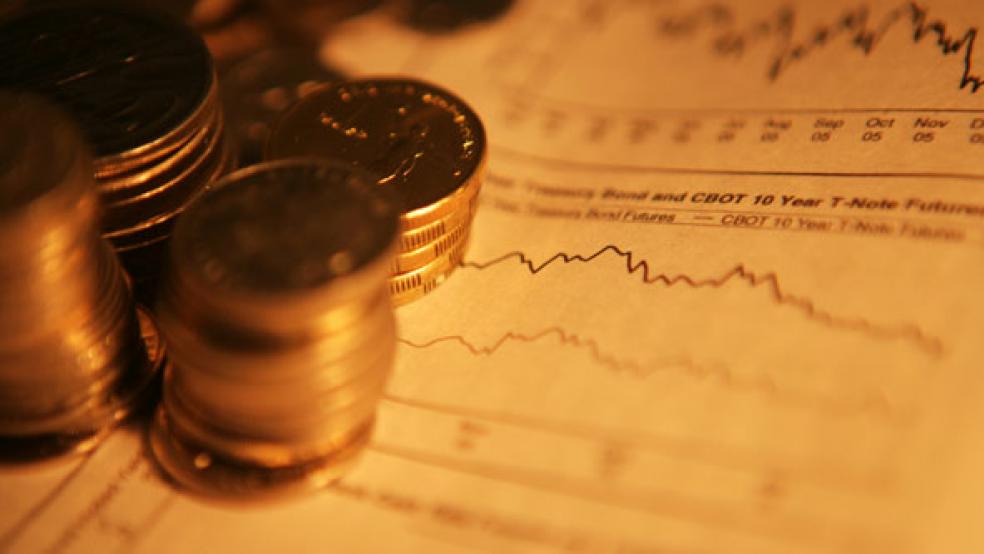Gold, which is considered a haven in uncertain times, jumped earlier this week after Standard & Poor’s lowered it’s outlook on U.S. government debt. Prices have risen to recent highs, topping $1,500 an ounce. The price of silver, meanwhile, exceeded $45 per ounce for the first time since 1980.
As the price of the precious metal surges to new highs, investors who might not ordinarily dabble in such things are wondering if gold should be in their portfolio. Although some advisers warn that gold is already overpriced, and may even be a bubble, others continue to tout gold as a way to diversify a portfolio and protect against inflation and a decline in the value of the dollar.
![]()
For investors who still want to take the plunge, there are several things to consider. The conundrum is that gold can be owned in different forms. Some are riskier than others. Liquidity varies, as do the costs associated with each form of the asset. Here's a look at just a few of the more popular ways to participate in today's gold rush.
Bullion and coins
Chances are, you can't store barrels of crude oil in your backyard. But when a commodity's price is pegged to the ounce instead of the barrel, you can hoard it in your house, stash it in a safe-deposit box or pay a company to store it for you.
If owning gold appeals to you, prepare to do a lot of reading and investigating before buying. Scammers are sure to congregate wherever the scent of investment money lingers in the air.
Gold dealers sell gold bullion bars in various weights from 1 ounce to 100 ounces or larger. You can also buy gold coins, such as the American Eagle, through dealers, brokerages and some banks. The U.S. Mint has a list of authorized dealers. You'll pay a commission or premium, and most dealers have purchase minimums. Be sure to study the differences between bullion gold coins, which are valued according to the market price for an ounce of gold, versus coins that have a collector's value.
Exchange-traded funds
Gold can carry concerns about authenticity and purity, as well as storage and insurance costs. But you can shed those worries and still own a chunk of gold by investing in exchange-traded funds that make buying and selling gold bullion as easy as buying and selling stocks.
The share price of streetTracks Gold Shares (GLD) roughly tracks the price of gold and represents an investment in gold bullion. In effect you get to own gold without the hassle of storing and insuring. "With GLD, each share is priced at about one-tenth the price of gold bullion. If gold goes to $600 an ounce then the price of a share should be about $60," says Martin Weiss, editor of Money and Markets.
The objective of iShares COMEX Gold Trust (IAU) is the same but, so far, is much less widely traded than GLD.
There are fees associated with exchange-traded funds but they're usually low. In addition, expect to pay a commission to your broker for each trade.
Stocks
Stocks are an investment in a publicly traded company. When it comes to gold stocks, you're investing in a mining company. Gold mining stocks can be more volatile than the exchange-traded funds.
"You're buying a company in the gold business and indirectly you get a stake in their gold reserves and their gold business. It's an indirect method of betting on gold. The streetTracks Gold Shares exchange-traded fund is far more direct," Weiss says.
"Mining stocks reflect the profits of the company. If it costs the company $250 an ounce to dig up gold, pay employees, gas and the like, and gold is selling at $375, their profit is $125. If the price of gold rises to $500 their profits have doubled, so the stock is more volatile. But it works the other way, too. A drop in the price of gold could flip-flop a company from one that's profitable to one that's bleeding."
Some of the most widely-held gold mining stocks include Newmont Mining (NEM), Placer Dome (PDG), Barrick Gold (ABX) and AngloGold Ashanti (AU).
Mutual funds
Advisers often tell do-it-yourself investors that the safest way to play the stock market is to buy mutual funds. That advice probably holds up well when looking for a foothold in gold, too. They're not always pure plays on gold, but that helps lessen volatility, says Mark Skousen, economist and chairman of Investment U, a free investment newsletter.
"I like the mutual funds that include a lot of different commodities including gas and oil such as U.S. Global Resources Fund (PSPFX). There are several out there that give you a little more investing in other areas rather than just precious metals.
Two other funds that were recommended in the course of researching this article are Prudent Global Income (PSAFX) and Vanguard Precious Metals and Mining (VGPMX). There are scores of other mutual funds that seek to give investors a stake in gold. Be aware that some funds might be more volatile than others and that expense and transaction fees can vary widely. Some funds may also charge a fee if you cash out before a certain holding period, usually six months to a year.
Jewelry
Buy gold jewelry because you like it, not as an investment. You pay a premium for jewelry, in part because of the design and craftsmanship. If you buy 14 karat gold, it's less pure than investment grade. When you sell, you'll need to consider the purity of the gold and, more than likely, it will have to be refined to bring it up to investment grade.




